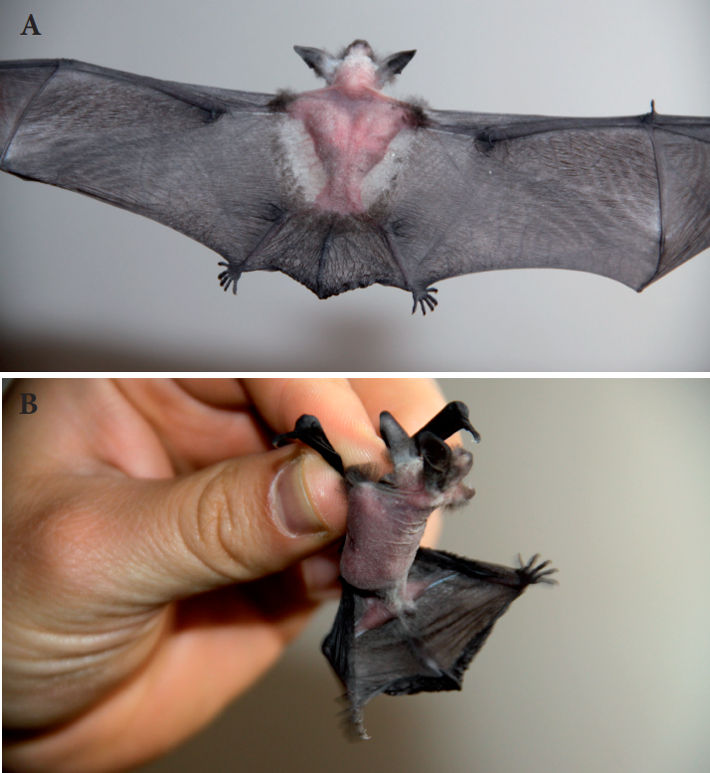Primer registro de alopecia en Myotis nigricans (Chiroptera: Vespertilionidae) en la ciudad de Manizales, Colombia
DOI:
https://doi.org/10.31687/saremNMS.2020.0.08Abstract
We document the first case of alopecia in the black Myotis bat Myotis nigricans (Schinz, 1821) in an urban environment of Colombia. This finding corresponds to a juvenile male with almost total alopecia in the dorsal and ventral areas of the body. The possible causes of the condition are discussed, and we highlight the importance of monitoring bat populations in cities.
References
Bello-Gutiérrez, J., G. Suzán, M. G. Hidalgo-Mihart, & G. Salas. 2010. Alopecia in bats from Tabasco, Mexico. Journal of Wildlife Diseases 46:1000–1004.
Blehert, D. S., et al. 2009. Bat white-nose syndrome: an emerging fungal pathogen? Science 323:227.
Borrero, C., L. M. Toro, M. Alvarán, & H. Castillo. 2009. Geochemistry and tectonic controls of the effusive activity related with the ancestral Nevado del Ruiz volcano, Colombia. Geofísica Internacional 48:149–169.
Brearley, G., et al. 2013. Wildlife disease prevalence in human-modified landscapes. Biological Reviews 88:427–442.
Calisher, C. H., J. E. Childs, H. E. Field, K. V. Holmes, & T. Schountz. 2006. Bats: important reservoir hosts of emerging viruses. Clinical Microbiology Reviews 19:531–545.
Castaño, J. H., J. D. Corrales, & S. Velázquez. 2003. Estructura y composición de la comunidad de murciélagos de un fragmento de bosque andino en la ciudad de Manizales – Caldas. Boletín Científico Museo de Historia Natural Universidad de Caldas 7:113–120.
Cena, K., & J. L. Monteith. 1975a. Transfer processes in animal coats. I. Radiative transfer. Proceedings of the Royal Society of London. Series B. Biological Sciences 188:377–393.
Cena, K., & J. L. Monteith. 1975b. Transfer processes in animal coats. II. Conduction and convection. Proceedings of the Royal Society of London. Series B. Biological Sciences 188:395–411.
Flux, J. E. 1970. Colour change of Mountain hares (Lepus timidus scoticus) in north-east Scotland. Journal of Zoology 162:345–358.
Frick, W. F., et al. 2010. An emerging disease causes regional population collapse of a common North American bat species. Science 329:679–682.
Haarsma, A. J., & J. van Alphen. 2009. Partial baldness in relation to reproduction in pond bats in the Netherlands. Lutra 52:83–95.
Kunz, T. H., E. Braun de Torrez, D. Bauer, T. Lobova, & T. H. Fleming. 2011. Ecosystem services provided by bats. Annals of the New York Academy of Sciences 1223:1–38.
Luis, A. D., et al. 2013. A comparison of bats and rodents as reservoirs of zoonotic viruses: are bats special? Proceedings of the Royal Society B: Biological Sciences 280:1–9.
Novak, M. A., & J. S. Meyer. 2009. Alopecia: possible causes and treatments, particularly in captive nonhuman primates. Comparative Medicine 59:18–26.
Morales-Martínez, D. M. 2013. Primer registro de Peropteryx pallidoptera (Chiroptera: Emballonuridae) en ecosistemas de Sabana. Therya 4:401–407.
Moratelli, R., A. L. Peracchi, D. Dias, & J. A. de Oliveira. 2011. Geographic variation in South American populations of Myotis nigricans (Schinz,1821) (Chiroptera, Vespertilionidae), with the description of two new species. Mammalian Biology 76:592–607.
Miller, Jr. W. H., C. E. Griffin, & K. L. Campbell (eds.). 2012. Muller and Kirk's small animal dermatology. 7th edition. Elsevier Health Sciences Press, Philadelphia.
Olsson, A., & S. Barnard. 2009. Alopecia. Bats in captivity: Biological and medical aspects, Vol. 1 (S. M. Barnard, ed.). Logos Press, Washington, D.C.
Pedersen, S. C., T. E. Popowics, G. G. Kwiecinski, & D. E. Knudsen. 2012. Sublethal pathology in bats associated with stress and volcanic activity on Montserrat, West Indies. Journal of Mammalogy 93:1380–1392.
Rodríguez-Posada, M. 2010. Murciélagos de un bosque en los Andes Centrales de Colombia con notas sobre su taxonomía y distribución. Caldasia 32:205–221.
Roncancio, N., & J. V. Estévez. 2007. Evaluación del ensamblaje de murciélagos en áreas sometidas a regeneración natural y a restauración por medio de plantaciones de aliso. Boletín Científico – Centro de Museos – Universidad de Caldas, Museo de Historia Natural 11:131–143.
Sánchez, F., P. Sánchez-Palomino, & A. Cadena. 2004. Inventario de mamíferos en un bosque de los andes centrales de Colombia. Caldasia 26:291–309.
Schneider, M. C., et al. 2009. Rabies transmitted by vampire bats to humans: an emerging zoonotic disease in Latin America. Revista Panamericana de Salud Pública 25:260–269.
Seltmann, A., G. Á. Czirják, A. Courtiol, H. Bernard, M. J. Struebig, & C. C. Voigt. 2017. Habitat disturbance results in chronic stress and impaired health status in forest-dwelling paleotropical bats. Conservation Physiology 5:1–14.
Tang, Z. H., et al. 2012. Alopecia in Rickett's Big-Footed Bat Myotis ricketti (Chiroptera: Vespertilionidae) in Relation to Age and Sex. Zoological Studies 51:494–499.

Downloads
Published
How to Cite
Issue
Section
License
Copyright (c) 2020 Juan D. Corrales Escobar, Carlos A. Saavedra Rodríguez

This work is licensed under a Creative Commons Attribution-NonCommercial 4.0 International License.

